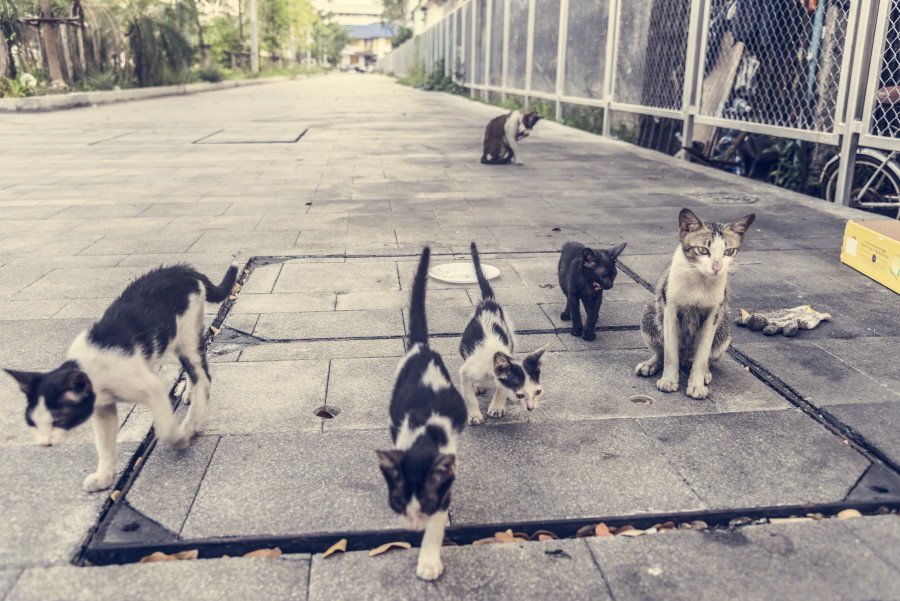There is nothing sadder than a feral cat left outdoors to fend for itself. Whether you got your feral or ferals through a shelter or lured them into your home, your heart is in the right place, and most feral cat lovers only adopt ferals because they are the throw-aways of the animal world.
Yes, you did the right thing – and in short, taming a feral cat is possible.
They need attention, affection, and most of all care, food, and a safe place to call home.
Table of Contents
Why Are There So Many Ferals?
These are simple answers:
– Cats can breed from four months of age, which makes them kittens having kittens
– Cats only have a gestation period of two months. Yes, two months, which makes each feral capable of having five litters of usually four to six kittens per year, although some have more, and some have less.
– Pregnant cats are very unwanted by owners. Dutiful owners get their cats spayed or neutered while others that are less responsible, neglect this because of vet bills. Once their cat becomes pregnant, sadly enough these neglectful owners simply abandon them. Once outside their offspring continue to breed early causing even more of a feral cat problem.
– Cats, unlike dogs, do not need to be microchipped or even licensed in many areas. Some areas of the United States, for example, allow an unlimited number of unsprayed and unneutered cats to be owned leading to a cat hoarding problem. Cat hoarders contribute to the feral cat population as some owners do not even know how many cats they have acquired.
But, There Are Some Problems with Ferals
Ferals can learn to be very loveable and are the MOST grateful cats in the world once they acclimate themselves to humans, other animals, and most of all living indoors.
Here are some problems that feral cat owners encounter with possible solutions.
Catching Feral Cats Can Be Hard
This is a number one problem as you must first obtain their trust to either get them into your home or into a cage. They do not come willingly to humans, especially if born outside as they have endured abuse and neglect tremendously.
“Cat haters” abound and ferals bear the brunt of this hate. No matter how battered, cold, tired, hungry, or ill, a feral will not usually approach a human. It will take time and patience. Leaving food outside is the first step. Then slowly reaching out while they eat is the next. This could take days, weeks, or months.
Cats are curious creatures though and once they feel comfortable enough, they will enter your home or a cage you have left outside. Especially if a spot is warm and cuddly!
Acclimating Feral Cats to Your Home & Indoor Life
The best advice a vet will give you is that it is best to confine a new feral to one room for a few days or a week. Too many strange experiences, noises, and territory can terrify them.
Feral Cats Might Not Be Friendly-Lap Cats
Do not expect a loving pet in the first few weeks or months even.
A feral will usually find a spot under the furniture where they will hunker for quite some time. Leave out a litter box and food and water right by that spot as surprisingly they usually know how to use it as cats outdoors even hide their droppings.
Don’t Try to Put a Collar on Right Away
Do not try to put on a collar or do anything special when first introducing a feral to home life. This will only make them backslide into their terror.
Visit a Veterinarian
If you can, take them to a vet, or have a vet visit as most feral cats have illnesses and parasites. This is crucial and some shelters have vets who will come to the home.
Expect Bites & Scratches
Ferals cannot speak and cannot tell you why they suddenly can lash out more frequently than other cats. PTSD (Post Traumatic Stress Disorder) is a real possibility here as the simplest things like the sight of a broom, or a plastic bag can turn them spastic.
Do Not Try to Pick Them Up!
You might be able to do this eventually but many ferals are never comfortable being picked up or carried as the loss of control bothers them.
Keep Other Pets & Kids Separated
Because of PTSD, you cannot know when a feral will be triggered by something. Try to keep children and other pets away from feral cats for at least a month. Consider setting up safe spaces for your feral cat, like a cat tower, cat caves and other areas where they can go to feel safe.
Get Ready for a LOT of Separation Anxiety
We are talking TONS of it here. Ferals become the most attached to the one person that saved them, and are known to yowl and howl, pace, and be very destructive even when you go outside briefly for the mail. Once you win them over, they will always at least be in the same room with you, if not sitting on you. If you go on vacations, expect to find pet-friendly hotels and motels, and resorts. Pet sitters do not work well with ferals.
They May Always Be Shy
Eventually, they will accept others in your life, but only for a brief while. You will always be the stability in their lives. They always will be wary of others.
You Will Need to Teach Them HOW to Play
Ferals spend all day hunting for food when outside so do not expect them to even know what toys are. Simple toys like lasers are best, as their hunting instincts are higher than in other domestic cats.
Food Might Be Challenging
Food can be a problem so it can help to feed a raw food diet. Since feral cats are accustomed to eating mice, rats or bugs, commercial cat food might not seem like real food to a feral cat. Raw food diets for cats are becoming popular, so definitely check that out!
Conclusions on Owning a Feral Cat
You will find a devoted pet inside a feral cat eventually, but most individuals are not ready for the length of time it can take depending upon the abuse and hard life they had as a feral cat. Most individuals expect the challenging behaviors to continue for only a few days, whereas some ferals display these behaviors for their entire lives.
There are cat behaviorists which can help possibly by educating you on how to cope with the behaviors, but cats learn behaviors early and these early learning phases are ingrained. Just accept your feral or ferals for what they are. They look like cats but can act as a “gorilla in a catsuit” many times. Keeping optimistic and accepting is necessary for successful feral cat ownership.

Jonathon Hyjek is an entrepreneur and cat-lover. He is married to Joy and they share their home with their 2 feline-friends, Franklin & Ollie. Jonathon is a self-admitted “Crazy Cat Guy”. He started this website because of his love for his own cats and their well-being.

